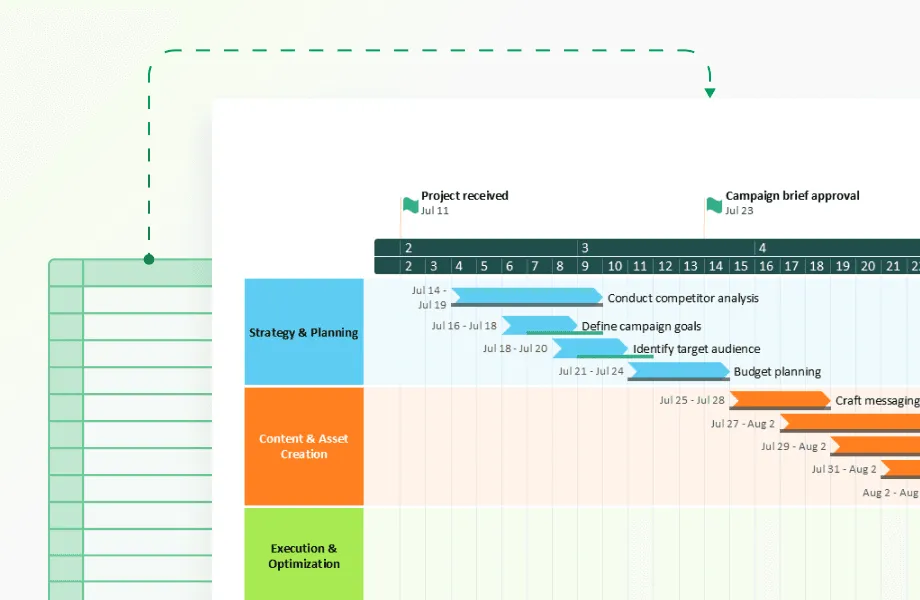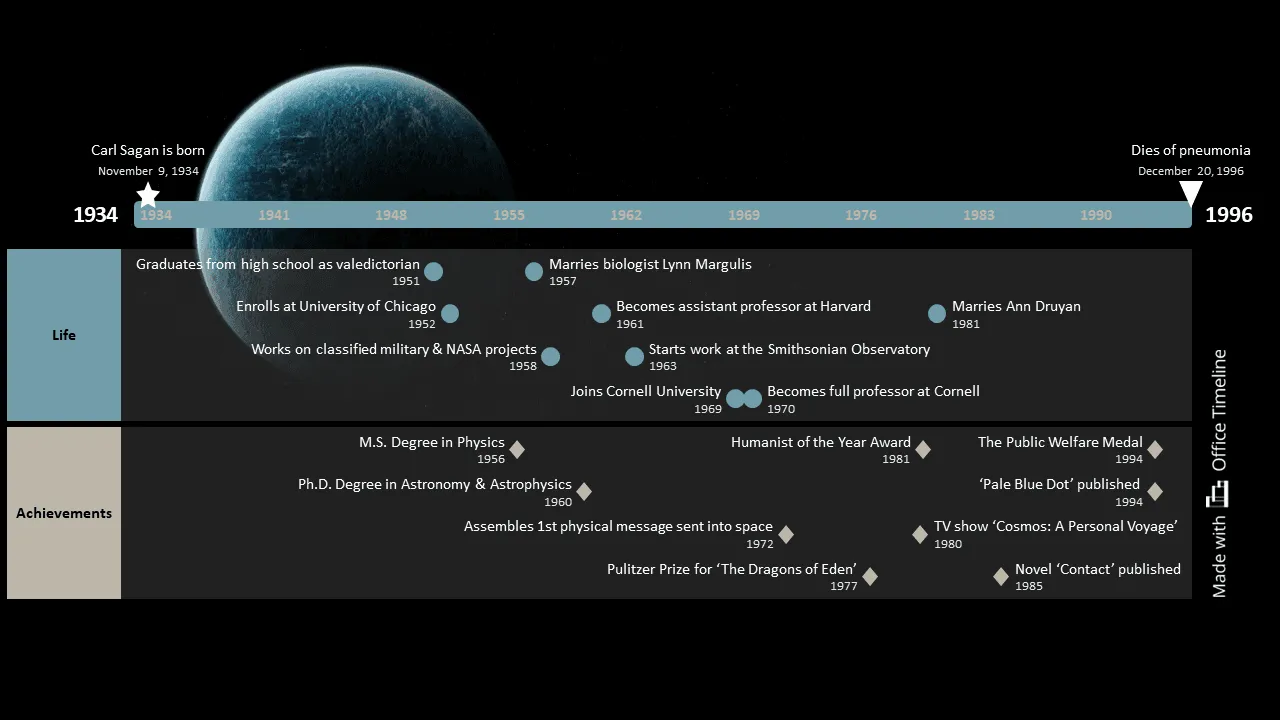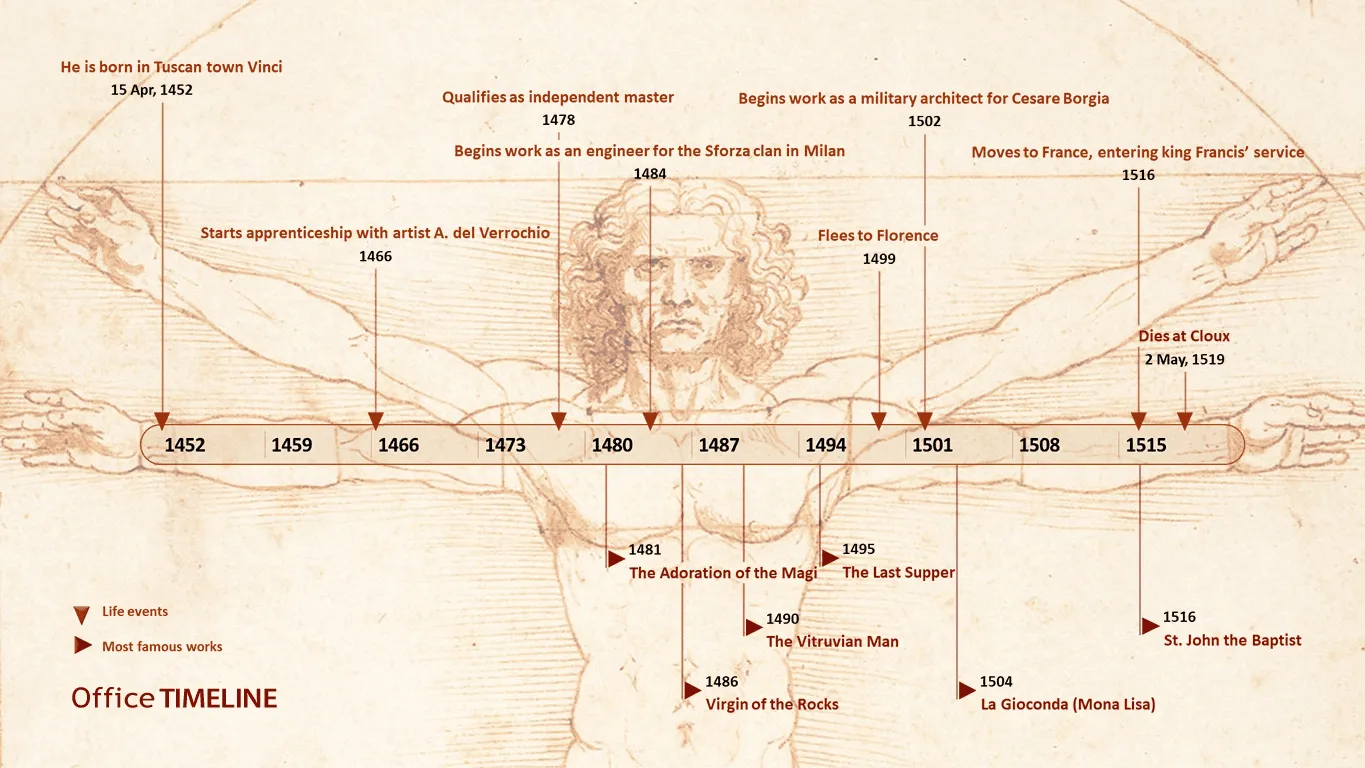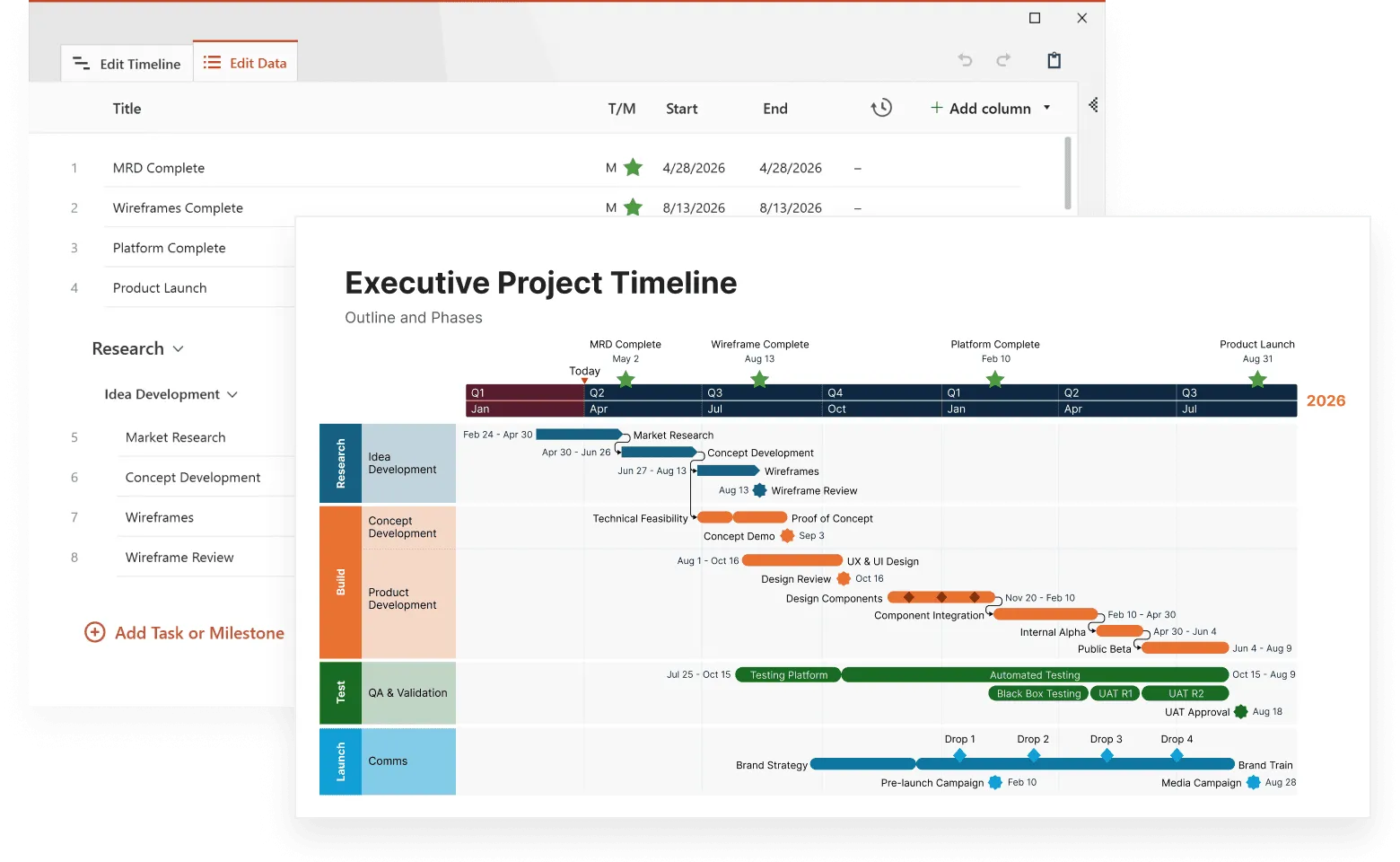When we think about someone's life, whether a historical figure like Abraham Lincoln or a personal hero, we often struggle to organize the scattered facts and achievements into a coherent picture. Dates and events float disconnected in our minds, making it difficult to understand how one moment influenced another.
Biographical timelines turn disconnected facts into a visual story. Far more than a simple list of dates and facts, a good life timeline transforms isolated moments into a visual story that reveals patterns, influences, and turning points. It offers readers a chance to see an entire life at a glance while understanding the context that shaped it.
As part of our series on different timeline types, this article examines how biographical timelines help us understand lives at a deeper level through chronological presentation.
What makes a biographical timeline unique?
A biographical timeline is a map of the moments that mattered, moments that changed everything or set something in motion. Birth, education, career breakthroughs, personal turning points, and yes, death. But not every event makes the cut. You're looking for the moments that actually shaped who this person became.
What makes timelines powerful is context. Take Carl Sagan. You could note that he created "Cosmos" in 1980 and move on. But a timeline shows you more: by then, he'd already spent years at Cornell, worked with NASA on multiple missions, and collaborated with the Smithsonian.
"Cosmos" wasn't a random TV show, it was the culmination of decades spent translating complex science for people who'd never use a telescope. The timeline connects the dots: all those years of work led to that one moment when millions of people looked up at the stars differently.
Reading the timeline
Carl Sagan's life shows a steady build from Brooklyn kid to science communicator who changed how millions saw the universe. Notice the 15-year gap between getting his Ph.D. (1960) and winning the Pulitzer (1977); those weren't empty years. He was teaching, researching, and learning to translate complex ideas into language anyone could understand.
By the time "Cosmos" aired in 1980, he'd spent two decades preparing for that moment. The timeline reveals what made him effective: he wasn't just a scientist who decided to go on TV. He was someone who built expertise first, then found ways to share it. His final book, "Pale Blue Dot" (1994), came just two years before his death. He was writing and teaching until the end.
This is what a good timeline does. It shows you how each moment connects to the next, how one decision opens a door that leads somewhere unexpected. You're seeing what happened but also how it all fit together.
Famous lives, new perspectives
When you look at someone's life laid out on a timeline, something clicks. You start seeing connections that regular biographies don't show: how different parts of their life overlapped, crashed into each other, or fed off one another.
Take Leonardo da Vinci. Everyone knows he painted the Mona Lisa. But here's what a timeline reveals: he started that painting in 1503, right after spending years as a military architect designing weapons and fortifications for Cesare Borgia. While the world's most famous portrait was taking shape on his easel, Leonardo was simultaneously in the service of the French king, doing military work.
The masterpiece we see in museums wasn't created by an artist in a peaceful studio. It emerged from the hands of someone who spent his days thinking about warfare, siege engines, and defense systems. The timeline shows you both tracks running side by side, which completely changes how you understand that gentle smile.
When history crashes into a life
Timelines also show you something textbooks usually miss: the exact moment when history stopped being background noise and became someone's personal crisis.
Look at Franklin D. Roosevelt. In 1921, polio paralyzed him from the waist down. He was 39, and his political career seemed over. But a timeline reveals what happened next: while he was learning to stand again with leg braces, the stock market crashed in 1929. By 1933, when he became president, he'd spent twelve years living with a disability that he had to hide from the public.
The man who told America "we have nothing to fear but fear itself" during the Depression had already fought his own private battle with fear and loss. You can see it right there: his polio years stacked against the country's economic collapse. It's the same timeline.
Unexpected overlaps
Sometimes timelines reveal connections that seem impossible. Anne Frank and Martin Luther King Jr. were born the same year, 1929. While Anne was hiding in an Amsterdam attic writing her diary, Martin was a teenager in Atlanta. She died in Bergen-Belsen in 1945; he was 16, beginning to find his voice.
When you see their lives on parallel timelines, something shifts. They weren't from different eras, they lived in the same world, facing different faces of the same human cruelty. These overlaps change how you think about history. It stops feeling like a neat sequence of separate stories and starts feeling like what it actually was: chaos happening everywhere, all at once.
That's the power of biographical timelines. They reveal the messy, surprising truth of how lives actually play out.
Your turn: building a biographical timeline
Whether you're mapping your own life or researching someone else's, creating a biographical timeline follows the same basic process: gather information, decide what matters, and lay it out so the story becomes clear.
Start with research
For historical figures, don't stop at Wikipedia. Dig into biographies, letters, interviews, and primary documents. Look for the dates that matter, like when something happened, but also the context around it. What else was going on in their life at that moment? What came right before or after?
For your own timeline, the research is different but just as important. Pull out old photos, documents, journals, emails. Talk to family members or former colleagues who remember things you've forgotten. You're looking for the dates and details that anchor your story.
Decide what makes the cut
This is the hard part: choosing what to include. A timeline that lists everything becomes noise. You want the moments that actually shaped the story, the ones that changed direction, revealed something, or set something else in motion.
Focus on:
- Formative experiences. What shaped who this person became? An early loss, a mentor, a place they lived?
- Major accomplishments. The work they're known for, but also the preparation that made it possible.
- Personal milestones. Relationships, family, health events that influenced other decisions.
- Turning points. When did things change? A career change, a move, a crisis?
- Historical context. What was happening in the world? Wars, economic shifts, cultural moments that intersected with this life?
What you leave out matters as much as what you include. A cluttered timeline loses its power. Be selective. The goal isn't to document everything, but to reveal the pattern.
How detailed should it be?
That depends on your purpose:
- For a quick overview: Stick to major milestones. Birth, education, career peaks, significant relationships, death. This gives someone the shape of a life in under a minute.
- For deeper understanding: Add the specifics: exact dates, locations, the names of people involved, what led to each moment. This level of detail helps you (or your readers) see cause and effect more clearly.
Choose the level of detail that serves your goal. If you're preparing for a job interview, you need different information than if you're writing a memoir or researching a historical figure.
Build a timeline in minutes
Try Office Timeline for free. Start with an easy template and instantly create a polished biography timeline in PowerPoint.

Life timelines in everyday contexts
You don't need to be famous for a timeline to reveal something important. Your own life, mapped out chronologically, can show you patterns you're too close to see otherwise.
Here are four types of personal timelines, each useful for different reasons:
Academic timeline
This tracks your education from first school through degrees, certifications, and major learning experiences. Include the institutions, the dates, the subjects you studied, significant projects or research, awards or recognition, and skills you gained.
What it reveals: How your interests evolved over time. Did you follow one passion straight through, or did you explore different fields before finding your focus? An academic timeline often shows the foundation for career choices that seem random without that context.
It also helps you explain gaps or pivots in your education, like why you took time off, changed majors, or went back for another degree later.
Practical use: Job applications, grad school essays, or simply understanding your own intellectual journey. When you see it laid out, you might notice that your "scattered" interests actually follow a thread you hadn't recognized.
Career timeline
Every job, promotion, lateral move, industry change, and professional milestone. Include company names, dates of employment, job titles, major responsibilities, key achievements, new skills learned, and the reasons you left (if relevant).
What it reveals: Your professional evolution. Are you climbing within one field or exploring different ones? How long do you typically stay in a role before moving on? Do you leave jobs when they plateau, or when external circumstances change?
A career timeline often reveals cycles: maybe you reinvent yourself every five years, or maybe you take on increasing responsibility in similar roles.
Practical use: Resume preparation, career planning, performance reviews, or figuring out your next move. When you see the pattern of your past choices, you can make better decisions about future ones. You might notice that your most satisfying roles shared certain characteristics, or that certain types of work consistently drain you.
Personal development timeline
This is the internal story: the timeline of becoming. Include when you learned significant new skills (not just job skills – these are not the only ones that matter; include life skills as well), shifted beliefs or perspectives, started or ended important relationships, made decisions that changed your direction, experienced personal breakthroughs or setbacks, and discovered new interests or passions.
What it reveals: Growth you might not have credited yourself for. We tend to think of ourselves as basically the same person we've always been, but a personal development timeline shows how much you've actually changed.
It connects internal shifts to external events. You might see that a difficult period led directly to a new capability or perspective you still rely on.
Practical use: Self-reflection, therapy, memoir writing, or understanding your own patterns. This timeline helps you see that growth isn't linear and that struggles often precede breakthroughs. It's particularly valuable when you feel stuck. Looking back shows you've navigated transitions before.
Life events timeline
The big external moments that anchor everything else. Include family births and deaths, marriages and divorces, relocations to new cities or countries, major health events, significant financial changes (windfalls or losses), accidents or crises, and historical events that directly affected you (wars, economic crashes, pandemics).
What it reveals: How external circumstances shaped your choices and opportunities. You might see that your career flourished after a major move, or that a health crisis redirected your priorities entirely.
Life events timelines often show that what felt like random bad luck or good fortune actually created the conditions for what came next.
Practical use: Understanding your own story, explaining your path to others, or preparing a family history. This timeline type is especially valuable for seeing how personal decisions intersected with forces beyond your control, and how you responded to both.
What you'll notice in your life timeline
When people create their first personal timeline, they often discover:
Invisible cycles
"I didn't realize I completely reinvent my career every five years" or "I always return to creative work after periods of analytical work."
Forgotten connections
"My best professional opportunity came right after I moved cities for personal reasons" or "That relationship I thought was a distraction actually taught me skills I use constantly."
Preparation you didn't see happening
"Those three 'random' side projects were actually preparing me for my current role" or "The skills I learned during that difficult job became essential later."
The long view
Struggles that felt permanent at the time turn out to be brief chapters. Successes that seemed sudden show years of invisible groundwork.
A personal timeline isn't about documenting everything, but also about seeing patterns in your own life that are invisible when you're living inside them. Once you see the pattern, you can work with it instead of against it.
Creating your timeline: tools and approaches
Once you've decided what to include in your timeline, you need to actually build it. You have options ranging from simple to sophisticated, depending on your needs and comfort level.
Start simple if you're exploring. Before investing in specialized tools, consider starting with what you already have:
Pen and paper
Seriously. Draw a horizontal line, mark key dates, and write brief descriptions above and below. This low-tech approach helps you think through what matters before committing to a format.
Spreadsheet
List events chronologically in Excel or Google Sheets with columns for date, event, category, and notes. You can sort, filter, and revise easily. It won't be beautiful, but it helps you organize your thinking.
Basic slide software
PowerPoint, Google Slides, or Keynote can create simple timelines with shapes and text boxes. You control every element, though it takes more manual work.
These simple approaches work well for personal exploration or rough drafts. But if you need something polished for presentations or sharing, specialized timeline tools make the process much faster.
Professional timeline makers
Office Timeline offers two versions designed for different situations, both focused on creating clean, professional timelines without design expertise.
Office Timeline add-in for PowerPoint
This plugs directly into PowerPoint on Windows, so you build timelines without leaving your presentation. It's useful when you're:
- creating a presentation that needs timeline slides;
- working offline or with sensitive information that shouldn't be cloud-based;
- already comfortable in PowerPoint and want to stay there.
You can import data from Excel instead of typing everything manually, customize colors and styles to match your presentation theme, and update the timeline quickly when dates or details change. The result integrates seamlessly into your slide deck, it's not a separate image you're inserting, it's part of the presentation itself.
Office Timeline Online
This runs in your browser with no software to install, which means you can work from anywhere: Mac, PC, tablet, whatever. It's better when you:
- need to access your timeline from multiple devices;
- want to collaborate with others (you can set view or edit permissions);
- prefer working in the cloud so everything auto-saves.
Your timelines live online, and you can download them as PowerPoint slides, PNG images, or Excel files depending on how you plan to use them. The cloud storage means you won't lose work if your computer crashes, and you can share a link instead of emailing files back and forth.
Which one?
They're separate products with separate subscriptions, so you'll need to choose based on how you work:
- Pick the PowerPoint add-in if you live in PowerPoint and need offline access.
- Pick the web version if you want flexibility across devices and easier collaboration.
Both produce professional results. The main difference is where you work (inside PowerPoint vs. in a browser) and where your files live (on your computer vs. in the cloud).
What about other timeline tools?
Office Timeline isn't the only option. Depending on your needs, you might also consider:
- Canva or Adobe Express: Good for one-off timelines with lots of visual design options, though less efficient for data-heavy projects or frequent updates.
- Dedicated timeline software: Tools like TimelineJS or Tiki-Toki offer different features, often better for interactive web-based timelines that people can explore online.
- Custom coding: If you have technical skills, you can build exactly what you want with libraries like D3.js, though this requires significant time investment.
For most people creating biographical timelines, whether for presentations, personal reflection, or family history, a tool like Office Timeline strikes the right balance between ease of use and professional results. You spend your time on content and insight rather than wrestling with design.
Conclusion: the power of life timelines
A timeline doesn't change what happened, but it does change how you see what happened.
When you lay out your life chronologically, patterns emerge that you couldn't see from inside your daily experience. The struggle that felt endless turns out to have lasted eighteen months. The "lucky break" that seemed random actually followed years of preparation you'd forgotten about. The decision that felt impulsive makes perfect sense when you see what came right before it.
This is true whether you're mapping your own life or studying someone else's. Biographical timelines reveal how circumstances, choices, and chance combine to shape a person, and how that person, in turn, shapes their world.
The timeline format does something that narrative storytelling can't quite manage: it shows you simultaneity, gaps, cycles, and turning points all at once.
What you can do with this
The principles you've seen in biographical timelines (chronological order, context, careful selection of what matters) apply far beyond personal life stories. You can use the same approach for:
- project histories (what actually happened versus what you planned);
- company evolution (how an organization changed over time);
- historical events (how different developments intersected);
- learning journeys (how you acquired knowledge or skills);
- creative projects (how a work evolved from idea to completion).
The format adapts. The insight remains the same: when you see things in order, with context, you understand them differently.
Your move
If you've been thinking about creating your own timeline, start simple. Pick one area of your life, such as career, education, relationships, whatever pulls at you, and map out the key moments. You don't need special software or design skills. A list with dates works. A hand-drawn line on paper works.
What matters is that you do it. Because your story, with all its contradictions, pivots, and unexpected connections, makes more sense when you can see it whole. And once you see the pattern, you can work with it instead of stumbling through it blind.
Your story matters. A timeline is just one way to finally see it clearly.
Frequently asked questions
If you're still figuring out whether a timeline makes sense for your case, or how to actually build one, these questions cover the practical details we didn't address above.
A life timeline serves as a detailed personal roadmap that highlights the significant milestones and key moments in your life, organized in chronological order. This visual representation allows you to easily track progress, identify patterns, and see at a glance your life’s journey. By documenting these important events in your life, you gain a clearer understanding of your life story and the major events that have shaped your personal and professional development.
Creating a life timeline can help you understand yourself better and set clear goals. By listing important events like graduating college, starting your first job, or moving to a new city, you can see how these moments have shaped your life. It's an easy way to look back at what you've done, recognize patterns, and plan your next steps. This process can help boost your self-awareness and also help you focus on specific goals, like advancing your career or nurturing personal relationships, based on your past experiences.
Creating a life timeline can be done efficiently using Office Timeline, which offers both PowerPoint integration and an online version. These tools provide customizable templates and design options to help you visually organize and present your life events in a polished manner.
In addition to Office Timeline, you can use Microsoft PowerPoint and Google Slides, tools that allow you to manually design your timeline with various styles and themes. For those who prefer a more tactile method, traditional paper and pens offer a personal touch, enabling you to sketch out your timeline with creativity and flexibility.
Choose the tool that best suits your needs and style, whether it's the professional polish of Office Timeline or the creative freedom of hand-drawn timelines.
Your life timeline's level of detail should align with its intended purpose. For a concise overview, focus on highlighting major life events such as graduations, career changes, and significant personal milestones. However, if you're aiming for a comprehensive record, ensure to include specific dates, locations, and the key people involved in each event to provide a richer, more nuanced account of your life's journey.




